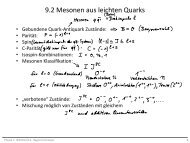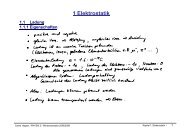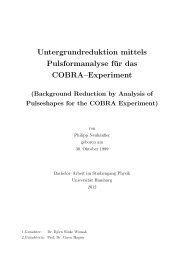2.4.2 Cosmic NeutrinosThe sources <strong>of</strong> the cosmic radiation causing the atmospheric neutrinos describedin the previous section are still not fully explored. Apart from particles associatedwith solar flares, the cosmic radiation comes from outside the solar system [33]. Itreaches energies exceeding 10 20 eV, leading to the expectation <strong>of</strong> also finding ultrahigh energy neutrinos among it. Neutrinos are not affected by absorption or electromagneticforces, so they reach the Earth on a direct path from their source. Thismakes them unique <strong>and</strong> <strong>of</strong>fers a great opportunity to use them as messenger particles,helping to find any point sources that could be identified as an origin <strong>of</strong> cosmicrays. Experiments like Antares [45] or IceCube [46] detect these neutrinos using theEarth as a target. Placed deep inside the water (ice), they look for the Čerenkovlight produced by high energetic muons or electrons produced in neutrino interactionwith the Earth. Ultra high energetic neutrinos are even capable <strong>of</strong> producingτs with energies high enough to propagate over a distance <strong>of</strong> the order <strong>of</strong> 100 m,before decaying <strong>and</strong> thus leaving a signature <strong>of</strong> two Čerenkov cones. Hence theseneutrino telescopes are sensitive to all neutrino flavors.2.4.3 Supernova NeutrinosThe hydrogen burning as a source <strong>of</strong> the energy released by starts as describedin Section 2.3 has a limited lifetime, depending mainly on the size <strong>of</strong> the star.During hydrogen burning, stars are in a hydrostatic equilibrium, meaning that itsgravitational forces are counterparted by its radiative pressure. Once the hydrogenis mostly burned up, the core <strong>of</strong> the star becomes more dense <strong>and</strong> the temperaturerises thus allowing fusion processes <strong>of</strong> heavier elements, again creating a hydrostaticequilibrium. This process continues for more <strong>and</strong> more heavy elements, leading toconcentric shells that are relics <strong>of</strong> the previous burning phases. However it has anend once the core contains mainly iron (Fe burning), since at this point no energycan be gained from fusion anymore.If, at this point, the core <strong>of</strong> the star exceeds the Ch<strong>and</strong>rasekhar mass limit<strong>of</strong> approximately 1.4M ⊙ , the core collapses due to the gravitational pressure toa neutron star. This is the case for stars more massive than 8M ⊙ <strong>and</strong> results inan optically very bright so-called core-collapse supernova. During the collapse, theso-called neutronization or deleptonization takes place converting large amounts<strong>of</strong> protons into neutrons by electron capture, thus emitting a vast number <strong>of</strong> ν e .The collapse is stopped when the core reaches densities ρ > 3 × 10 14 g cm −3 , avalue normally found for atomic nuclei. The nuclear forces now start to becomerepulsive, the core is no further compressible <strong>and</strong> matter bounces back. ν¯ν pairs <strong>of</strong>all flavors are produced <strong>and</strong> the core cools down by their emission. This simplifiedpicture shows that a supernova leaves a distinct signature in the neutrino spectrum:First the emission <strong>of</strong> ν e lasting a few milliseconds followed by the emission <strong>of</strong> allneutrino types for about 10 s. In these processes, neutrinos carry away 99% <strong>of</strong>the energy released in the supernova with typical energies <strong>of</strong> 10 MeV per neutrino.Again, the neutrinos involved can be used as messenger particles giving an earlywarning <strong>of</strong> an upcoming (visible) supernova in the electromagnetic spectrum. Mostcurrent neutrino experiments capable <strong>of</strong> detecting supernova neutrinos are thereforeconnected to the socalled SuperNova Early Warning System SNEWS. In the event16
Figure 2.3: Expected ¯ν e energy distribution for geo-neutrinos from the 238 U, 232 Th<strong>and</strong> 40 K chain. The dashed line indicated the sensitivity limit for detection via inverseβ decay. Figure from [49].<strong>of</strong> a galactic supernova at a distance <strong>of</strong> approximately 8kpc, about 100 neutrinointeraction within a few seconds would be expected in the Borexino experiment.2.4.4 Geo-NeutrinosGeo-neutrinos (¯ν e ) are produced in β decays <strong>of</strong> radionuclides inside the Earth. Theywere originally proposed bye G. Eder [47] <strong>and</strong> G. Marx [48] in the 1960s.The processes inside the Earth are to a large extent still unknown. Seismologistsare able to reconstruct the density pr<strong>of</strong>ile <strong>of</strong> the Earth but not its composition. Andsamples taken from holes dig in the upper crust <strong>of</strong> the Earth’s outer mantle can onlytell about the geochemical properties up to depth in the order <strong>of</strong> a few kilometers.Questions about the influence <strong>of</strong> radionuclides to the terrestrial heat productionor the composition <strong>of</strong> the Earth’s core remain unanswered. The investigation <strong>of</strong>geo-neutrinos can give an answer to the abundance <strong>of</strong> radioactive elements insidethe Earth. The hypothesis <strong>of</strong> a natural fission reactor in the Earth’s core can beaddressed.Neutrino sources inside the Earth are radioactive nuclear isotopes with half-lives<strong>of</strong> the order <strong>of</strong> the Earth’s age or longer. These are mainly 238 U, 232 Th <strong>and</strong> 40 K. Theresulting energy spectrum from their decay chains is depicted in Fig. 2.3. The picturealso marks the sensitivity limit for the detection <strong>of</strong> geo-neutrinos via the inverseβ decay, which has a threshold energy <strong>of</strong> 1.806 MeV. This way only selected geoneutrinosfrom the 238 U <strong>and</strong> 232 Th chains can be detected. The relative abundances<strong>of</strong> the different sources can then be identified by comparing the measurements tothe different distinct energy spectra. The existence <strong>of</strong> geo-neutrinos was first shownby KamLAND in 2005 [49] <strong>and</strong> recently confirmed by the Borexino experiment [50].Measurements in different locations can give new constraints on the thorium <strong>and</strong>uranium abundances in the Earth’s crust <strong>and</strong> mantle. The study <strong>of</strong> geo-neutrinoscan also help to underst<strong>and</strong> the terrestrial heat production, that is a tiny heatflux <strong>of</strong> approximately 60 to 90 mW/m 2 emitted by the Earth. Although this is a17





